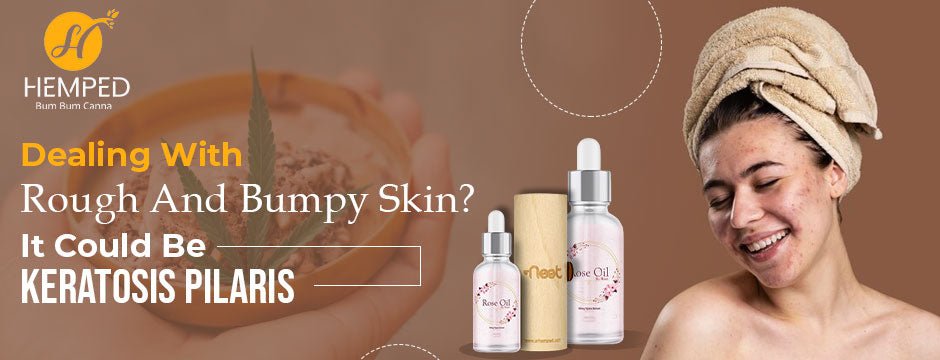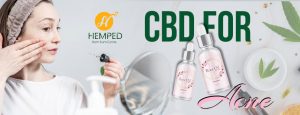
CBD for Acne: Can CBD Treat Keratosis Pillaris?
Have you been dealing with rough and bumpy skin that even exfoliation fails to treat? You could be suffering from Keratosis Pilaris, a common and harmless skin condition which affects people of all ages and races. While many people are aware that using CBD for acne works wonders, very few know that it can also be useful in managing other inflammatory skin conditions such as keratosis pillars and psoriasis.
The cause of keratosis pilaris is thought to be a slow accumulation of keratin in the skin's hair follicles. On the back of the upper arm, it typically appears as a rough, little white lump. Despite not being painful or even fatal, how it looks and feels may cause worry in the person who has it. These days, modifying one's diet and moisturising are the most frequently suggested remedies.
Regular hydration aidss in hastening the healing process because it appears that having slightly dry skin makes injuries develop. Even though these dermatological conditions are not considered fatal, their visual manifestations may have a significant psychological and social impact.
Table of Contents
What causes Keratosis Pilaris, and what is it?
A deposit of the hair protein keratin in the pores causes Keratosis Pilaris, a common yet benign skin disease. If you have keratosis pilaris, your skin's keratin clogs your pores and prevents your hair follicles from sprouting. As a result, a tiny lump appears where the hair ought to be. You can find tiny body hair poking out if you pick at the bulge. Although the precise cause of keratin buildup is unknown, doctors believe it may be linked to hereditary disorders and skin illnesses like atopic dermatitis.
Based on a physical examination and medical history, keratosis pilaris can be identified. Usually, a dermatologist only needs to examine the affected region to establish the diagnosis. Your age, how your skin appears, and which places it affects are all factors in the diagnosis. There is no official test to confirm the keratosis pilaris diagnosis.
The emergence of keratosis pilaris is its most striking sign. The visible tiny bumps on the skin mimic goosebumps or the skin of a chicken that has been plucked. Hence the name “chicken skin”.
The soles of your feet and the palms of your hands will never develop pimples since hair follicles can grow anywhere on the skin. Upper arms and thighs are frequent locations for keratosis pilaris. In excess, it might reach the lower legs and forearms. Other symptoms include lumps that feel like sandpaper, bumps that are slightly pink or red around them, and itchy, irritated skin. Depending on the person's skin tone, bumps can also be flesh-coloured, white, red, pink, brown, or black.
While there are no OTC creams or ointments that can completely cure KP, the condition can still be managed. Treatment options include laser, chemical peels, regular exfoliation, and lotions and moisturisers with keratocytes such as Ammonium Lactate in them.
You can use CBD for acne, inflammation, and other symptoms caused by KP.
Exfoliate, but gently
Gently exfoliating without hurting or aggravating the issue is the key to eliminating dead skin and unplugging the hair follicles. Use natural, gentle exfoliants to exfoliate dead skin cells and aid in the skin's ability to retain moisture, such as sea salt, which has anti-inflammatory effects. Avoid using rough washes because they might worsen the issue by causing tiny skin tears.
You can make your DIY scrub by combining sea salt and natural honey. To increase its skin-benefitting properties, you can mix additional components like jojoba oil, coconut oil, CBD for acne, rose oil, etc. Gently apply this mixture to the afflicted region, then rinse with warm water.
Although a scrub that smooths the skin provides immediate satisfaction, experts concur that chemical exfoliation, which utilises acids to dissolve dead skin gradually, is the most effective method for treating keratosis pilaris. Topical lotions, creams, or serums containing glycolic acid, lactic acid, salicylic acid, or urea are options for chemical exfoliation. Retinol or a prescription-strength retinoid can work wonders for some folks. Using CBD for acne and inflammation is particularly beneficial as it soothes mild inflammation that often occurs after exfoliation.
But remember that maintaining control of KP requires a strict programme of moisturising and exfoliating. When the creams are applied consistently, the skin will become smoother, and eventually, the redness around the bumps will fade, but if therapy is stopped, the bumps will return.
Dry Brushing
You can benefit from dry brushing if you have keratosis pilaris. With regular dry brushing, dead skin cells are eliminated, and pores are helped to open up. You can use a soft, natural bristle brush and gently brush every part of your body. Before you wet your skin, make sure to do this. Don’t be harsh as it can worsen the situation by aggravating redness and inflammation.
The idea behind dry brush is to improve lymphatic drainage and unclog the hair follicles that are the source of bumpy spots. Dry brushing is also beneficial for those who suffer from cellulite. Following your dry brushing session, take your regular shower and pat your skin dry. Apply a natural oil, such as coconut or rose oil, to your entire body, including the affected areas. Neet rose oil is a great option as it contains CBD for acne and other skincare benefits.
Some individuals, however, should refrain from dry brushing or proceed cautiously. It would be best if you didn't brush dry over an irritated area of the skin for anyone with open or inflamed skin, including those with eczema and psoriasis. Additionally, you ought to refrain from dry brushing an open wound. You might spread bacteria to the wound, increasing the risk of infection. Not everyone may benefit from dry brushing. Before dry brushing, see your doctor if you have sensitive skin or a disease like psoriasis. Use CBD for acne-prone and inflammation-prone skin post dry brushing as a precautionary measure.
Avoid harsh soaps
Using harsh soaps can strip your skin of its natural oils, which can further worsen keratosis pilaris. It is advisable to use sulphate free and moisturising soaps that can gently clean your skin. The purest, most natural, and chemical-free ingredients make the best body soaps. Short warm baths might assist in loosening and unclogging pores.
However, keeping bathtime brief is crucial because prolonged soaks can deplete the body's natural oils. By introducing moisture to the air in a space, humidifiers can also help preserve the moisture in your skin and reduce itchiness. Exfoliating your skin every day might make it look better. Dermatologists advise using a soft loofah or pumice stone to remove dead skin gently.
Moisturise Religiously
It would be best if you moisturise daily using natural, non-irritating solutions. Applying a natural moisturiser like avocado to the afflicted areas will help to reduce inflammation and replenish hydration, leaving the skin feeling dewy rather than rough and flaky when paired with gentle exfoliating or dry brushing. Retinol or vitamin A is another useful treatment for keratosis pilaris as it is known to support skin cell regeneration. Moreover, when it comes to moisturising, CBD for acne-prone skin is a brilliant moisturiser as it provides hydration and combats inflammation at the same time.
Your dermatologist can put you on retinol for the same. In addition, moisturising emollients can be useful by retaining moisture. Emollients are all created to soften and hydrate dry skin, giving it the moisture it desperately needs to stay in good, smooth condition. This reduces dryness, itching, and roughness while regulating and normalising the skin's regenerative process.

CBD for Acne and Keratosis Pilaris
Although many other factors may influence whether using CBD for acne and other skin concerns would benefit your skin or other components might work for you, it may be useful for rough skin. Cannabidiol, sometimes known as CBD, is one of cannabis' active ingredients. Because of its mild nature and potent antioxidants, it is excellent for all skin types and helps with several skin concerns.
Using CBD for acne bumps is helpful as it soothes sensitive skin, moisturiser dry skin, and speeds up the healing process for injured skin. Using CBD for acne and skincare is also beneficial for lowering acne-related irritation and redness because it also contains anti-inflammatory qualities. CBD is a great skincare component for sensitive skin and disorders like keratosis pilaris because of its calming qualities.
For those looking for a hypoallergenic skincare regimen, using CBD for acne and other skin concerns such as KP is a perfect alternative because it is a herbal ingredient for lowering redness, inflammation, sensitivity, and reactivity. According to research, CBD is anti-inflammatory, making it useful for lowering redness and swelling from various skin conditions, including acne, rosacea, psoriasis, keratosis pilaris, and more.
Using CBD for acne works because of the ability of CBD to reduce excessive sebum (oil) production is another advantage for acne patients. Due to its composition of potent antioxidants, it's an excellent choice to take CBD for acne, inflammation, wrinkles, and other skin problems. Antioxidants combat the free radicals that cause oxidation and harm our skin cells. Regular application of CBD for acne and other benefits to the skin will protect it from daily UV and pollution damage, preserving its youthful appearance and minimising the appearance of bumpy skin.
Conclusion
Although there is no over-the-counter remedy for acne typical to keratosis pilaris, the issue is typically treatable with the right skincare and safety measures. While using CBD for acne does provide relief, it is better to see a dermatologist if the condition is extreme and causes severe discomfort. Stop utilising these keratosis pilaris treatment methods immediately if they irritate your skin and worsen your symptoms.
Just enough exfoliation, done gently, should remove the top layer of your skin's dead skin cells. Keep a close eye on how your skin responds if you use lotions that include chemicals. Stop the treatment if the afflicted regions become hot, itchy, or irritating. Consult a dermatologist before use CBD for acne and KP, especially if you have trouble managing the issue or experience discomfort frequently.
